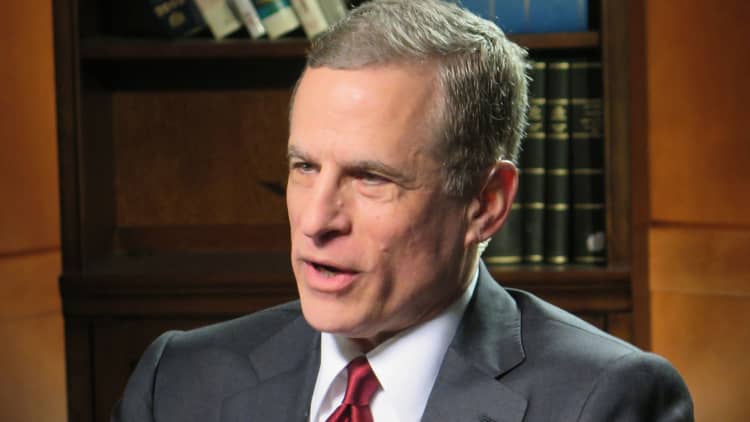
Dallas Fed President Robert Kaplan, in an interview Tuesday with CNBC, set out a course for a fairly aggressive path of rate hikes coupled with reductions in the central bank's balance sheet for the remainder of the year.
However, he doesn't think that's because the economy is about to take off.
Instead, Kaplan sees growth likely continuing on the path of about 2 percent and not the 3 percent or more boom in gross domestic product that President Donald Trump and his economic advisors have been forecasting.
"Two things drive GDP: growth in the labor force and growth in productivity," he said in a live interview on "Squawk Box." "The problem is labor force growth is very sluggish. And my own judgment and our economists at the Dallas Fed think it's going to continue to be sluggish the next 10 years because the population is aging and labor force
Still, Kaplan said he foresees two more interest rate increases in 2017 and a start to the process of unwinding the Fed's $4.5 trillion bond portfolio, most of which was accumulated after the financial crisis.
"I think that removal of accommodation should be done gradually and patiently," he added.
Kaplan is president and CEO of the Federal Reserve Bank of Dallas and a voting member of the Fed's policy-setting committee.
The Fed is widely expected to hike its benchmark interest rate in June, a move that would push the target range up to 1 percent to 1.25 percent. The market has not priced in another hike this year, though, with an additional move in December currently being given just a 49 percent chance, according to the CME.
In addition, central bank officials at their meeting earlier this month agreed on a process to start letting a to-be-determined amount of the bonds on the balance sheet to roll off each month.
The balance sheet ballooned during three rounds of bond buying the central bank conducted in an effort to boost the economy after the Great Recession. While stock market values soared during the quantitative easing effort, broader economic growth has been mired around the 2 percent range.
Kaplan said the balance sheet should be "substantially less" than it is today but conceded that it likely will remain above $2 trillion.
"I don't want to put a specific number on it. If somebody says in the 2s, that sounds about right to me," he said.
On the economy, Kaplan was less enthusiastic about the prospects for significantly stronger growth.
Trump has laid out a pro-growth agenda of tax cuts, reduced business regulations and stronger infrastructure spending that he believes can lift the economy out of its post-financial crisis malaise.
While Kaplan said some of those ideas would be positive for the economy, he warned that restrictions on immigration could be
"If it's tax reform, I think that could be helpful. If it's a tax cut financed by increasing the deficit, my concern is that may give a short-term bump to GDP growth, but not a sustainable bump to GDP," he said. "And over the


